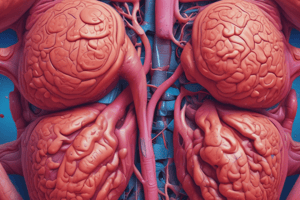Podcast
Questions and Answers
A patient with renal disease expresses a sense of hopelessness and a lack of motivation to adhere to their treatment plan. Which of the following counselling strategies would be most effective in initially addressing this?
A patient with renal disease expresses a sense of hopelessness and a lack of motivation to adhere to their treatment plan. Which of the following counselling strategies would be most effective in initially addressing this?
- Providing detailed information on the latest treatment options and technological advancements in renal care.
- Directly challenging the patient's negative beliefs and presenting statistical data on treatment success rates.
- Emphasizing the importance of following medical advice and the potential consequences of non-compliance.
- Exploring the patient's past experiences and identifying any instances where they successfully overcame challenges. (correct)
A renal patient being counselled is in the contemplation stage of change regarding their diet. Which statement best reflects their current state?
A renal patient being counselled is in the contemplation stage of change regarding their diet. Which statement best reflects their current state?
- They have recently started a new dietary plan and are actively working towards their goals.
- They are unaware of the need to change their diet and do not see it as relevant to their condition.
- They acknowledge the importance of dietary changes but are ambivalent and not yet ready to take action. (correct)
- They have already made significant changes to their diet and are consistently adhering to it.
When is it most appropriate to give advice to a patient?
When is it most appropriate to give advice to a patient?
- When the patient is seeking assurance on issues with unpredictable outcomes.
- When the patient is facing immediate physical danger and a directive approach is needed to reduce risk. (correct)
- When the patient seems dependent on others to make decisions and needs to learn to choose their own courses of action.
- When the patient is just there to check things out.
Which of the following approaches is most aligned with the principles of effective brainstorming with renal patients to improve their treatment adherence?
Which of the following approaches is most aligned with the principles of effective brainstorming with renal patients to improve their treatment adherence?
According to Shahgholian & Yousefi (2018), what is a common sentiment expressed by patients undergoing hemodialysis regarding social interactions?
According to Shahgholian & Yousefi (2018), what is a common sentiment expressed by patients undergoing hemodialysis regarding social interactions?
A menopausal patient is having difficulty accepting changes to her body and sexuality. Which of the following counseling interventions would be most appropriate?
A menopausal patient is having difficulty accepting changes to her body and sexuality. Which of the following counseling interventions would be most appropriate?
A patient undergoing menopause expresses feelings of being overwhelmed and unable to find any positive aspects of this life stage. What would be the most effective initial step in reframing this perspective?
A patient undergoing menopause expresses feelings of being overwhelmed and unable to find any positive aspects of this life stage. What would be the most effective initial step in reframing this perspective?
Which of the following is the most common age range for women experiencing menopause?
Which of the following is the most common age range for women experiencing menopause?
A menopausal patient reports increased irritability and emotional instability, leading to conflicts in family relationships. Which approach would be most beneficial in addressing these issues?
A menopausal patient reports increased irritability and emotional instability, leading to conflicts in family relationships. Which approach would be most beneficial in addressing these issues?
A menopausal patient is having trouble sleeping. Which of the following is the most appropriate recommendation?
A menopausal patient is having trouble sleeping. Which of the following is the most appropriate recommendation?
When counseling a patient with erectile dysfunction, which approach is most likely to foster a collaborative environment?
When counseling a patient with erectile dysfunction, which approach is most likely to foster a collaborative environment?
A patient with erectile dysfunction expresses fear that their partner will leave them. How should a counselor best address this concern?
A patient with erectile dysfunction expresses fear that their partner will leave them. How should a counselor best address this concern?
What initial step should a counselor take when 'boiling down the problem' during an erectile dysfunction counseling session?
What initial step should a counselor take when 'boiling down the problem' during an erectile dysfunction counseling session?
Which of the following goals set during counseling for erectile dysfunction is likely to be most effective?
Which of the following goals set during counseling for erectile dysfunction is likely to be most effective?
A couple attends counseling where the man has ED. What statement reflects addressing ED as a shared issue?
A couple attends counseling where the man has ED. What statement reflects addressing ED as a shared issue?
Flashcards
Patient Readiness
Patient Readiness
Patients demonstrate varying levels of readiness and motivation, categorized as Visitors (browsing), Complainants (checking things out), or Customers (ready to receive help).
Precontemplation
Precontemplation
Person not thinking about taking action.
Action
Action
Person has made specific changes in their life.
The Miracle Question
The Miracle Question
Signup and view all the flashcards
New Learning Experiences
New Learning Experiences
Signup and view all the flashcards
Reframing
Reframing
Signup and view all the flashcards
Menopause Symptom Charting
Menopause Symptom Charting
Signup and view all the flashcards
Themes in Menopause Experiences
Themes in Menopause Experiences
Signup and view all the flashcards
Menopause Transition
Menopause Transition
Signup and view all the flashcards
Talking About Menopause
Talking About Menopause
Signup and view all the flashcards
Why is assessment important?
Why is assessment important?
Signup and view all the flashcards
Purpose of questioning
Purpose of questioning
Signup and view all the flashcards
Why set goals?
Why set goals?
Signup and view all the flashcards
Psychological effects of ED on the individual
Psychological effects of ED on the individual
Signup and view all the flashcards
How to help patients and partners cope with ED
How to help patients and partners cope with ED
Signup and view all the flashcards
Study Notes
- Week 14 focuses on erectile dysfunction, covering counseling and phenomenology.
Assessment and Goal Setting
- Assessment involves gathering patient information and is an ongoing process.
- Information should be collected from different sources.
- Questioning can be seen as an “art,” and used to spur patient’s thinking, stimulate action, and focus patients on their goals.
- Questioning serves an Orienting function.
- Categorizing patients and problems involves diagnosis and identification of issues.
- A list of problems should be created and prioritized by the patient.
- Helpers should select methods and techniques to treat, and co-construct the treatment plan with the patient.
- Goal setting separates the problem into manageable units.
- Goals act as a source of motivation and hope for clients.
- Every visit should have a focus
- Goals help to know when the relationship should end
Effective Goal Setting
- Goals should be specific, positively stated, simple, and concrete.
- Clear goals lead to better progress.
- Turning problems into goals can improve motivation.
- Concrete goals are especially important for demoralized clients, with consideration given to measuring frequency, duration, and intensity.
- Behavioral goals should be concrete, measurable, and observable, demonstrating the effectiveness of the helping relationship.
- Not all goals need to be behavioral if they are are specific and clear, simple and concrete, and positively stated.
- Patients must be willing to take responsibility for the problem, their feelings, and the goal.
- It is important patients are motivated and “own” the goals.
- Patients feeling part of the team can contribute positively towards treatment.
- Goal achievement indicates when the work is done or when future sessions can move on to new problems.
- Goals should be important to the patient and personally meaningful goals can help patients work harder.
- Realistic goals should be doable or achievable.
- Questions can be used in goal setting to make the goal more specific, turn a problem into a goal, determine a goal’s importance or to enhance collaboration.
Effective Problem Solving
- Step One: Summarize and enumerate the issues while agreeing on content.
- Step Two: Ask the client to identify the most crucial issues, using closed questions to prioritise problems.
- Step Three: Select the focal problem, focusing on only one or two issues at a time.
- Step Four: Change the problem to a goal using solution-focused questioning.
- Step Five: Ensuring the client and helper are clear, restate and clarify the final goal statement.
Phenomenology of Erectile Dysfunction
- Erectile dysfunction's psychological consequences for the individual can include: emasculation, humiliation, perceived inability to please partners, fear of abandonment, apprehension about new relationships, and performance anxiety.
- Erectile dysfunction's psychological consequences for the partner can include: a complex mixture of rejection, guilt, feeling unloved, shame, frustration, and withdrawing from sex.
Counselling Patients and Partners
- It is important to address erectile dysfunction as a shared sexual problem of both heterosexual and same-sex relationships.
- Encouraging the patient to bring their partner facilitates a relational assessment and a unified approach.
- Identify norms that are specific to the couple.
- High-quality sexual education addresses potential faulty knowledge.
- Open and honest discussion of sexual functioning is needed.
- Encourage couples to "avoid" avoidance.
- Effective communication skills, such as empathic/reflective listening, de-escalation, and reframing, should be used.
- Referral to a behavioral specialist should be considered.
Studying That Suits You
Use AI to generate personalized quizzes and flashcards to suit your learning preferences.




